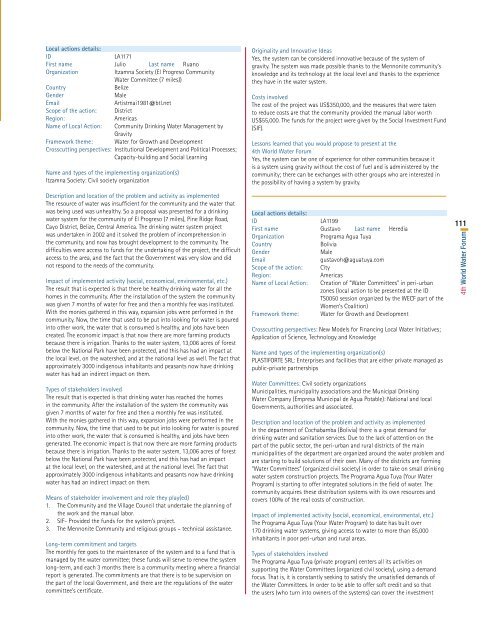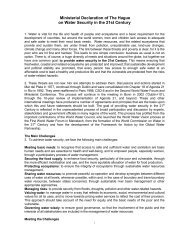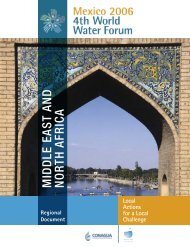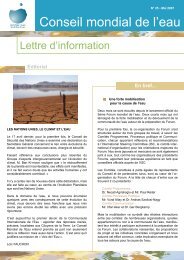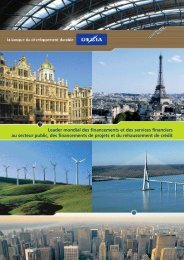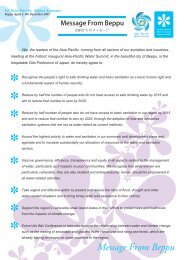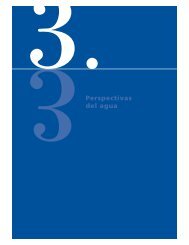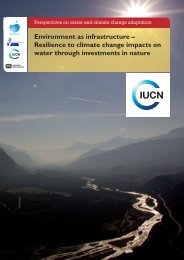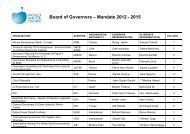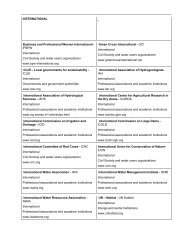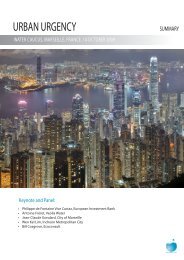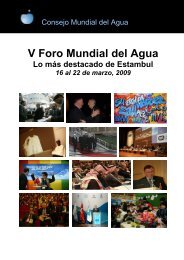Americas ok.indd - World Water Council
Americas ok.indd - World Water Council
Americas ok.indd - World Water Council
You also want an ePaper? Increase the reach of your titles
YUMPU automatically turns print PDFs into web optimized ePapers that Google loves.
Local actions details:IDLA1171First name Julio Last name RuanoOrganizationItzamna Society (El Progreso Community<strong>Water</strong> Committee (7 miles))CountryBelizeGenderMaleEmailArtistmai1981@btl.netScope of the action: DistrictRegion:<strong>Americas</strong>Name of Local Action: Community Drinking <strong>Water</strong> Management byGravityFramework theme: <strong>Water</strong> for Growth and DevelopmentCrosscutting perspectives: Institutional Development and Political Processes;Capacity-building and Social LearningName and types of the implementing organization(s)Itzamna Society: Civil society organizationOriginality and Innovative IdeasYes, the system can be considered innovative because of the system ofgravity. The system was made possible thanks to the Mennonite community’sknowledge and its technology at the local level and thanks to the experiencethey have in the water system.Costs involvedThe cost of the project was US$350,000, and the measures that were takento reduce costs are that the community provided the manual labor worthUS$55,000. The funds for the project were given by the Social Investment Fund(SIF).Lessons learned that you would propose to present at the4th <strong>World</strong> <strong>Water</strong> ForumYes, the system can be one of experience for other communities because itis a system using gravity without the cost of fuel and is administered by thecommunity; there can be exchanges with other groups who are interested inthe possibility of having a system by gravity.Description and location of the problem and activity as implementedThe resource of water was insufficient for the community and the water thatwas being used was unhealthy. So a proposal was presented for a drinkingwater system for the community of El Progreso (7 miles), Pine Ridge Road,Cayo District, Belize, Central America. The drinking water system projectwas undertaken in 2002 and it solved the problem of incomprehension inthe community, and now has brought development to the community. Thedifficulties were access to funds for the undertaking of the project, the difficultaccess to the area, and the fact that the Government was very slow and didnot respond to the needs of the community.Impact of implemented activity (social, economical, environmental, etc.)The result that is expected is that there be healthy drinking water for all thehomes in the community. After the installation of the system the communitywas given 7 months of water for free and then a monthly fee was instituted.With the monies gathered in this way, expansion jobs were performed in thecommunity. Now, the time that used to be put into lo<strong>ok</strong>ing for water is pouredinto other work, the water that is consumed is healthy, and jobs have beencreated. The economic impact is that now there are more farming productsbecause there is irrigation. Thanks to the water system, 13,006 acres of forestbelow the National Park have been protected, and this has had an impact atthe local level, on the watershed, and at the national level as well. The fact thatapproximately 3000 indigenous inhabitants and peasants now have drinkingwater has had an indirect impact on them.Types of stakeholders involvedThe result that is expected is that drinking water has reached the homesin the community. After the installation of the system the community wasgiven 7 months of water for free and then a monthly fee was instituted.With the monies gathered in this way, expansion jobs were performed in thecommunity. Now, the time that used to be put into lo<strong>ok</strong>ing for water is pouredinto other work, the water that is consumed is healthy, and jobs have beengenerated. The economic impact is that now there are more farming productsbecause there is irrigation. Thanks to the water system, 13,006 acres of forestbelow the National Park have been protected, and this has had an impactat the local level, on the watershed, and at the national level. The fact thatapproximately 3000 indigenous inhabitants and peasants now have drinkingwater has had an indirect impact on them.Means of stakeholder involvement and role they play(ed)1. The Community and the Village <strong>Council</strong> that undertake the planning ofthe work and the manual labor.2. SIF- Provided the funds for the system’s project.3. The Mennonite Community and religious groups – technical assistance.Long-term commitment and targetsThe monthly fee goes to the maintenance of the system and to a fund that ismanaged by the water committee; these funds will serve to renew the systemlong-term, and each 3 months there is a community meeting where a financialreport is generated. The commitments are that there is to be supervision onthe part of the local Government, and there are the regulations of the watercommittee’s certificate.Local actions details:IDLA1199First name Gustavo Last name HerediaOrganizationPrograma Agua TuyaCountryBoliviaGenderMaleEmailgustavoh@aguatuya.comScope of the action: CityRegion:<strong>Americas</strong>Name of Local Action: Creation of “<strong>Water</strong> Committees” in peri-urbanzones (local action to be presented at the IDTS0050 session organized by the WECF part of theWomen’s Coalition)Framework theme: <strong>Water</strong> for Growth and DevelopmentCrosscutting perspectives: New Models for Financing Local <strong>Water</strong> Initiatives;Application of Science, Technology and KnowledgeName and types of the implementing organization(s)PLASTIFORTE SRL: Enterprises and facilities that are either private managed aspublic-private partnerships<strong>Water</strong> Committees: Civil society organizationsMunicipalities, municipality associations and the Municipal Drinking<strong>Water</strong> Company (Empresa Municipal de Agua Potable): National and localGovernments, authorities and associated.Description and location of the problem and activity as implementedIn the department of Cochabamba (Bolivia) there is a great demand fordrinking water and sanitation services. Due to the lack of attention on thepart of the public sector, the peri-urban and rural districts of the mainmunicipalities of the department are organized around the water problem andare starting to build solutions of their own. Many of the districts are forming“<strong>Water</strong> Committees” (organized civil society) in order to take on small drinkingwater system construction projects. The Programa Agua Tuya (Your <strong>Water</strong>Program) is starting to offer integrated solutions in the field of water. Thecommunity acquires these distribution systems with its own resources andcovers 100% of the real costs of construction.Impact of implemented activity (social, economical, environmental, etc.)The Programa Agua Tuya (Your <strong>Water</strong> Program) to date has built over170 drinking water systems, giving access to water to more than 85,000inhabitants in poor peri-urban and rural areas.Types of stakeholders involvedThe Programa Agua Tuya (private program) centers all its activities onsupporting the <strong>Water</strong> Committees (organized civil society), using a demandfocus. That is, it is constantly seeking to satisfy the unsatisfied demands ofthe <strong>Water</strong> Committees. In order to be able to offer soft credit and so thatthe users (who turn into owners of the systems) can cover the investment1114th <strong>World</strong> <strong>Water</strong> Forum


